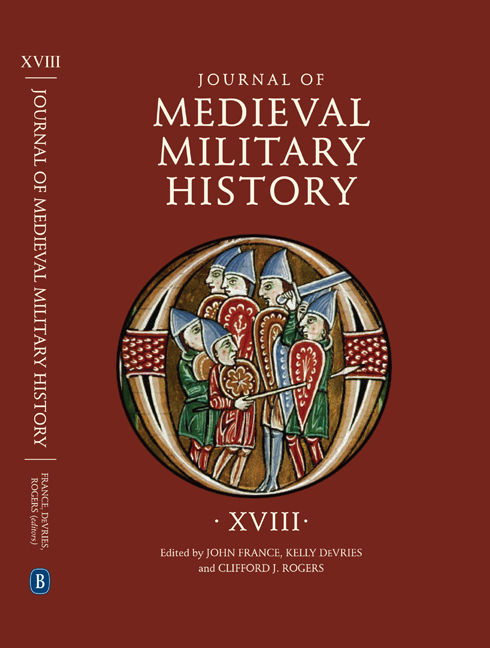Book contents
- Frontmatter
- Contents
- List of Illustrations
- 1 The Eastern Campaigns of King Henry II of Germany, 1003–17
- 2 Peace, Popular Empowerment and the First Crusade
- 3 The Transformation of Naval Warfare in Scandinavia during the Twelfth Century
- 4 Auxiliary Peoples and Military Reform on Hungary’s Western Frontier in the Thirteenth Century
- 5 What Types of Sources Did Medieval Chroniclers Use to Narrate Battles? (England and France, Twelfth to Fifteenth Centuries)
- 6 Experimental Tests of Arrows against Mail and Padding
- 7 Four Misunderstood Gunpowder Recipes of the Fourteenth Century
- 8 The Earliest Middle English Recipes for Gunpowder
- 9 Horses and Horsemen in Fifteenth-Century Siege Warfare, with Particular Reference to the Later Hundred Years War
- 10 Supplying the Army: The Siege of Pisa, 1499
- List of Contributors
- Journal of Medieval Military History 1477–545X
10 - Supplying the Army: The Siege of Pisa, 1499
Published online by Cambridge University Press: 06 October 2020
- Frontmatter
- Contents
- List of Illustrations
- 1 The Eastern Campaigns of King Henry II of Germany, 1003–17
- 2 Peace, Popular Empowerment and the First Crusade
- 3 The Transformation of Naval Warfare in Scandinavia during the Twelfth Century
- 4 Auxiliary Peoples and Military Reform on Hungary’s Western Frontier in the Thirteenth Century
- 5 What Types of Sources Did Medieval Chroniclers Use to Narrate Battles? (England and France, Twelfth to Fifteenth Centuries)
- 6 Experimental Tests of Arrows against Mail and Padding
- 7 Four Misunderstood Gunpowder Recipes of the Fourteenth Century
- 8 The Earliest Middle English Recipes for Gunpowder
- 9 Horses and Horsemen in Fifteenth-Century Siege Warfare, with Particular Reference to the Later Hundred Years War
- 10 Supplying the Army: The Siege of Pisa, 1499
- List of Contributors
- Journal of Medieval Military History 1477–545X
Summary
This essay will describe the first major operation launched by an Italian army against a heavily fortified city after the assimilation of the Frenchstyle artillery into the warfare of the Peninsula. The paper will examine, in particular, the preparations for this “marvellous enterprise,” stressing the difficulties with the procurement of munitions during the early stages of employment of the new guns.
Based on state accounts and local chronicles, the article demonstrates that, from the last years of the fifteenth century onwards, the issue of military supply compelled Italian regional states to develop the manufacture of ordnance, shot, and powder, facing a “revolutionary challenge” in terms of management, commerce, and production.
By September 1498, the soldiers of Florence were coming close to ending the Pisan rebellion, after three long years of wearing campaigns and diplomatic stalemates. As a result of an all-out offensive, the army had eventually occupied a large area of the enemy countryside, seizing the towns of Buti, Calci, Vico, and Ripafratta. Only the city of Cascina did not surrender to the captain-general, Paolo Vitelli, whose mastery of siege artillery was a significant determinant of this successful, brisk operation.
Once again, however, a decisive victory was hampered by an external intervention. The Venetian invasion of the mountain region of Casentino, in October 1498, diverted Florentine attention from the reconquest of Pisa. The menace of a heavy defeat represented a serious problem for the troubled Republic, now compelled to fight on two fronts, “with a daily expenditure of one thousand and fifty hundred florins.” Only after five months of stalemate did the opponents, encouraged by Ludovico Sforza, enter into negotiations. They were both wearied by “the draining of wells full of ducats” and “the bargaining, the extortion” of their mercenaries.
In the first days of April 1499, however, the two peace agreements proposed by the duke of Ferrara, Ercole d’Este, dissatisfied each one of the three contenders. Pisans protested firmly against the numerous, important concessions to Florentines, such as the cession of public incomes, the relinquishment of city fortresses, and the appointment of foreign criminal judges. Considering the pact as the beginning of the end of the “popular freedom,” they said they would prefer to abandon the city, or to die bravely, defending the walls against their “bloodthirsty” enemy, rather than “live under Florentine custody.”
- Type
- Chapter
- Information
- Journal of Medieval Military HistoryVolume XVIII, pp. 245 - 282Publisher: Boydell & BrewerPrint publication year: 2020

